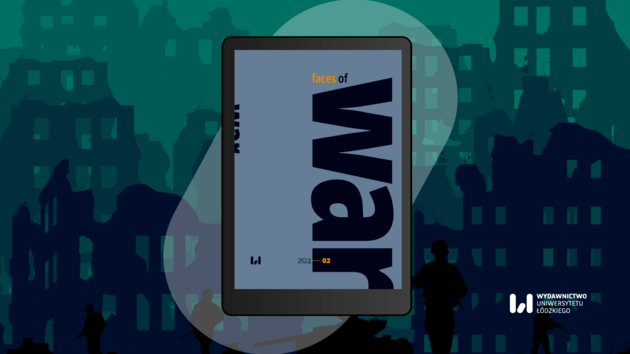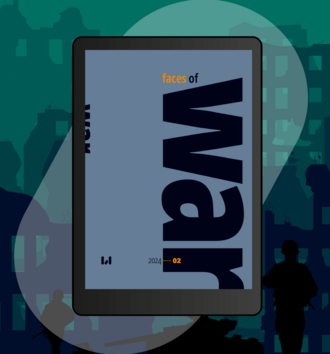FACES of WAR is a journal dedicated to armed conflicts from ancient times to the present day. It is an extension of the Oblicza Wojny series, published since 2020 by the Lodz University Press. The new periodical, FACES of WAR, is a peer-reviewed biannual journal published in English, fully available online and free of charge. This allows authors to regularly share the results of their research.
A distinctive feature of FACES of WAR is its interdisciplinary approach to the issues discussed in the journal. Therefore, we accept papers from the humanities as well as from disciplines such as international relations, law, security studies, architecture, and urban planning. FACES of WAR is a journal that publishes original studies and presents diverse perspectives that inspire reflection and discussion.
-
An Examination of Sassanian Siege Warfare (3rd to 7th centuries CE) – Kaveh Farrokh:
This article examines Sassanian siege warfare and technology in the domains of ballistae, ‘scorpions’, catapults, and battering rams. Sassanian siege warfare necessitated the use of protection/shielding for personnel (combat troops, engineers, laborers), mounds, mining, scaling of walls, as well as the digging of ditches and trenches. Archery barrages played a seminal role in support of siege operations. The arteshtārān (lit. warriors; mainly paighan infantry, archers, and savārān cavalry) and pil-savār (elephant warriors/riders) would undertake combat operations with manual labour provided by peasant recruits. Battle elephants could also be used in siege operations (for example at Nisibis, 350 CE). The environmental element of water was utilised (for example during the sieges of Nisibis, 337 or 338 CE and 350 CE). Incendiary factors could also be weaponised in siege operations. In summary, Sassanian siege warfare capabilities appear to have achieved proficiency levels equivalent to contemporary Roman armies.
-
Tumultus ac trepidatio in urbe. Social Perceptions and Effects of War in Rome and Some Italic Cities in the Late 3rd Century B.C. – Viviana Capelli:
From the Second Punic War onwards, it is possible to identify significant episodes regarding war's effects on Rome and other Italic cities. Apart from their military defence system, the perception of a state of war, its implications and the consequent feelings experienced by citizens of these urban settlements is still an unexplored field, since modern historiography has chosen to focus on the mere war events instead of exploring these less evident, but equally important issues related to them.Nevertheless, it is useful to examine the atmosphere caused by this state of emergency, such as tumultus ac trepidationes, conplorati and metus in cities which, being fortified centres, were the safest places for seeking refuge. Accordingly, this study aims to describe these kinds of situations – physical, psychological and mental health conditions endured by inhabitants of urbes and oppida during wartime. Ancient written sources, particularly the third decade of Livy’s Ab Urbe Condita, and also Polybius will provide valuable historical information about these matters and the broader institutional, social and anthropological context of the Roman Republic at the end of the 3rd century B.C.E.
-
Military Service of Knights, Vogts and Village Mayors in the Kingdom of Poland under the Reign of Władysław II Jagiełło: Legal Regulations – Krzysztof Gryglewski:
The reign of Władysław Jagiełło in Poland was highly significant. He not only established a new dynasty but also succeeded diplomatically and militarily in foreign policy. His forty-year reign was also a time of granting privileges, which was necessary to win the support of the nobility and to execute the king’s will. This led to changes in military obligations, allowing the nobility to gain prerogatives, including the right to war prisoners. The king also repeated and extended existing privileges, such as the right to be paid for military campaigns on foreign territory and the right to compensation for the losses of equipment and horses. These changes were significant both militarily and politically and reinforced the nobility’s power within the kingdom. Changes in military services of the feudal system in Poland, which occurred during the reign of Władysław II Jagiełło, were essential in understanding the future military evolution of the Polish army.
-
Grand Tour Correspondence in the Time of War: The Early Stages of the War of the Spanish Succession in the Letters of Henry Bentinck, Viscount Woodstock and His Tutor Paul Rapin-Thoyras (1701–1702) – Michaël Green:
Letters sent during a Grand Tour, an early modern educational journey, are often considered important sources for the history of tourism and travel, history of diplomacy or family relations. However, the example of the correspondence of the Anglo-Dutch nobleman Henry Bentinck, Viscount Woodstock and his Huguenot tutor, Paul Rapin-Thoyras with Woodstock’s father, Hans Willem Bentinck, the 1st Earl of Portland, demonstrates that these letters can also contain important information on various military aspects and provide another view on known events such as during the War of the Spanish Succession. In this article, several examples of such cases are examined, together with the alternative, fuller story of the capture of the French Marechal De Villeroy by the Imperial forces. Portland, whose letters are not preserved, was a close friend of King William III of England and was a key figure in Anglo-Dutch politics at the time, thus being in the midst of the events. The analysis is conducted based on Grand Tour letters written in French and sent from various locations both by the pupil and his tutor.
-
A Comprehensive Examination of the 1852 Persian Military Manual: ‘General Regulations for the Exercises and Marches of the Infantry of the Esteemed Government of Iran’ – Manouchehr Moshtagh Khorasani:
This article deals with the study and analysis of an important Persian military manual, entitled ‘General Regulations for the Exercises and Marches of the Infantry of the Esteemed Government of Iran’ (قواعد کلیه از برای مشق و حرکات پیاده نظام دولت علیه ایران). The manual, a historical artefact of considerable importance, is dated Ramadan 1268 Hijra, corresponding to June 1852 CE, a period marked by the reign of Nāssereldin Shāh Qajar. The manual is a testament to the modernisation efforts initiated by Crown Prince Abbās Mirzā during the early Qajar era. It provides a unique insight into the military strategies and training methods of the time, reflecting the transformative changes within the Iranian military. Comprising 51 pages and adorned with 35 illustrations, the manual provides a comprehensive guide to training exercises for armed and unarmed infantry troops. It provides insight into the rigorous training regimes and tactical manoeuvres of the Persian infantry in the mid-19th century. Thus, the manual is not merely a military guide but a historical document that provides information on the evolution of Persian military tactics in response to the modernisation efforts of the time.
-
Regional Office for Aid to the Victims of War in Prague (1919–1938) – David Hubený:
The killings and mutilations brought about by World War I left a significant mark on society: missing husbands and fathers, surviving war veterans, widows and orphans. The newly formed Czechoslovakia had to deal with this tragic legacy and care for the 600,000 men, women, and children affected by the war. To do this, it was necessary to strengthen the relevant public administration apparatus, as the existing social security was not prepared for such a burden. The new state could not fail where the Habsburg monarchy had already failed, ceasing to perform its basic social and economic functions for its population.The Czechoslovak Republic, consisting of several higher-level administrative-territorial units called ‘lands’ (země), began to create regional offices and authorities to provide care for disabled soldiers or men who had fallen ill as a result of military service, widows of deceased soldiers, widows of disabled veterans of the war and post-war years, as well as parents of deceased or disabled victims of the war and from the post-war years.This paper will describe the legislative framework of the authorities using the example of the Regional Office for Aid to the Victims of War in Prague, its functioning and organisation of personnel, as well as the types of cases handled by the authorities and their reception by socjety.
-
Community Resilience Dimensions of Agency and Human Values in the Response of Polish Border Communities to the Refugee Crisis Caused by the Russian Invasion of Ukraine in 2022 – Natalia Bełdyga:
This research aims to explore the role of community resilience in response to the refugee crisis caused by the Russian invasion of Ukraine on February 24, 2022 by specifically studying two core dimensions of community resilience, namely agency and human values, to see if they helped to build and enhance community resilience to crisis and uncertainty. In this respect, two cases of responses to the refugee crisis made by two Polish border communities in two corners of Poland, one in the northeast, in Suwałki, in the borderland area often referred to as Suwałki Gap, and the second one in the southeast, in Biecz, known as ‘Little Kraków,’ have been analysed by conducting qualitative interviews with research participants in three interview groups of volunteers, community members, and municipality who privately or professionally provided help for Ukrainian refugees arriving to Poland. Qualitative results of the analysis reveal that deep awareness of members of both Polish border communities about who the aggressor is and who the defender is in the conflict between Russia and Ukraine was the main motivation to activate distinct values of, among others, compassion or mutuality that influenced the response to the arrival of Ukrainian citizens fleeing their invaded homeland and seeking safety and security in Poland – which was mainly a demonstration of sympathy and solidarity with Ukrainian refugees. The findings also reveal that one of the core community resilience dimensions – agency – was exercised collectively and individually, both bottom-up and top-down. Although the decisions were mostly spontaneously dictated by the needs of the heart, the decisions to act were made purposefully. In light of the current refugee crisis, of which the Italian island of Lampedusa is the centre, and with which EU countries have been attempting to cope, it is crucial to continue further research about the cases of responses to such crises, specifically the reactions of the most affected responders. The results of the empirical research on the analysed cases of responses to the refugee crisis and uncertainty caused by the Russian invasion of Ukraine on February 24, 2022 made by Polish border communities may contribute to the existing research and discourse on the role and impact of citizens’ and communities’ resilience potential in disaster response and preparedness.
-
Conveying the Tragedy of War Through Unconventional Photography Methods –Yulia Ivashko, Aneta Pawłowska, Serhii Belinskyi, Andrii Dmytrenko:
This article analyses the specificity of conveying the tragedy of war through artistic photography. Comparing photos from the Vietnam War and the contemporary Russian-Ukrainian war illustrates how the range of figurative means has expanded. Photography of the Vietnam War had a narrow range of topics and limited methods of conveying content. In contrast, Ukrainian frontline photography is more diverse, with unconventional techniques emerging in military artistic photography. Many romantic photographs depicting landscapes and animals have surfaced, and the role of symbolism in photographic images has increased. This article aims to highlight the differences between past and present frontline photography while emphasising the greater symbolism and hidden meaning present in contemporary photography, as the tragedy of war resonates with the viewer through indirect allusions.
-
Ukraine’s Air Defence in the Russian-Ukrainian War (2022–2024): Progress in Regression – Andrij Kharuk:
Russia’s full-scale aggression against Ukraine, which began on February 24, 2022, posed serious challenges to the Ukrainian air defence system. Its traditional instruments – long- and medium-range anti-aircraft missile systems (S-300, Buk-M1) and fighter aircraft (MiG-29, Su-27) – did not always prove effective in the new conditions. It was necessary to repel mass attacks from cruise missiles which were characterised by having a small deflection area and the ability to fly at low-altitude targets. In September 2022, the Russians started to use numerous attack drones called Shaheds, which meant that the Ukrainian air defence had to adapt quickly to the new threat. In order to combat these missiles, mobile fire groups with machine guns and MANPADS on pickup trucks began to be used, which quickly advanced towards the enemy attack. The equipment used by these mobile fire groups was gradually improved. One example was from the Czech Republic, where Viktor sets were created. These consisted of twin-barrelled machine guns from the 1940s combined with thermal imaging cameras and mounted on pick-up trucks. German FlakPz Gepard self-propelled anti-aircraft guns transferred by partner countries also proved very effective. In NATO countries, this equipment was considered obsolete in the 1990s, but between 2022–2024 in Ukraine, it effectively destroyed UAVs and cruise missiles. Light training and sports aircraft, provisionally armed with machine guns and using tactics from World War I, have been successfully used to fight unmanned aerial vehicles. These examples show that even in regression, as highlighted by a return to air defence measures from previous decades, progress can be made to adapt to new threats from the air. This article aims to present the unconventional air defence measures used by the Armed Forces of Ukraine to eliminate the threat posed by Russian aerial attack assets.



